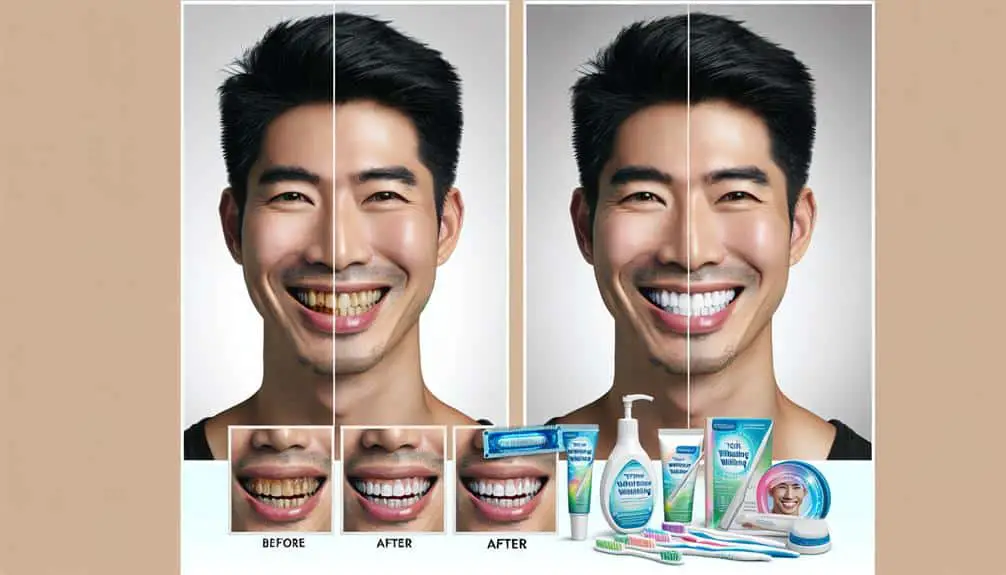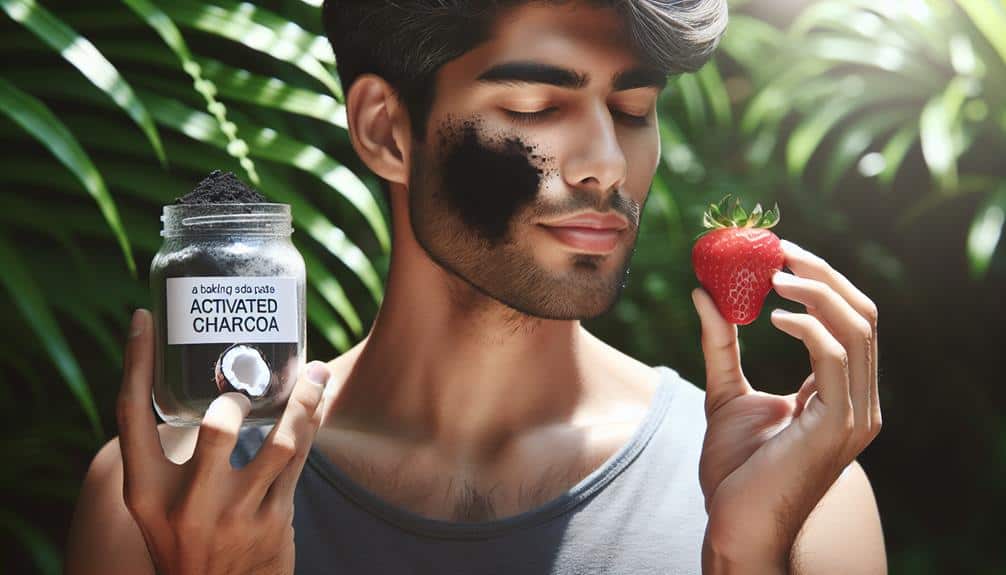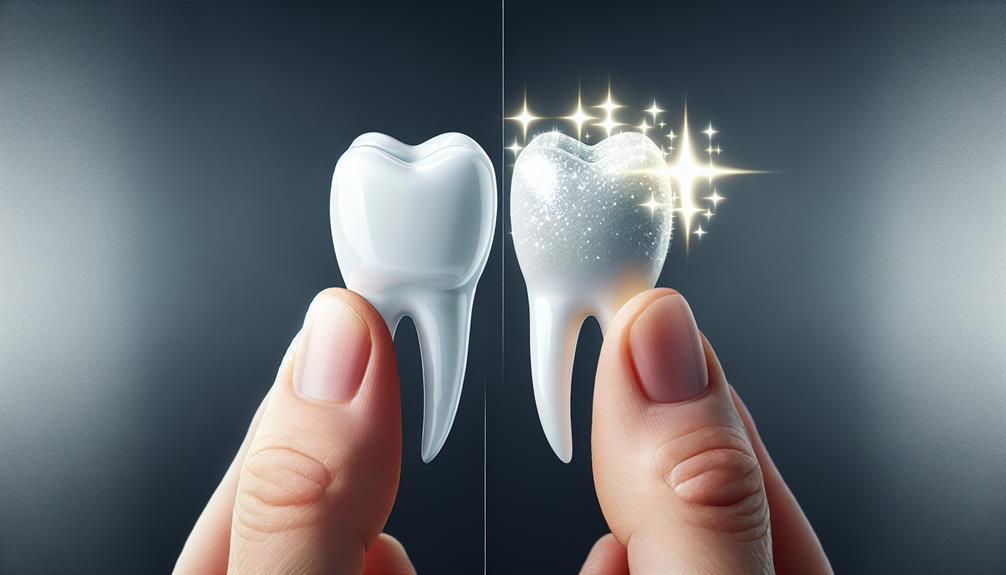For whitening tetracycline stained teeth, consider professional teeth whitening treatments with a licensed dentist who can provide tailored solutions like laser whitening in a controlled setting. At-home whitening kits with carbamide peroxide or hydrogen peroxide from trusted brands like Crest Whitestrips are convenient options for maintenance. You might also explore natural remedies such as sage or DIY solutions with baking soda for a brighter smile.
While whitening toothpaste and mouthwash can help, adopting preventive measures like gentle brushing and regular dental check-ups are key for long-term results. Expert advice and additional tips can further enhance your journey to a whiter smile.
Key Points
- Consult a dentist for professional whitening options tailored to tetracycline stains.
- Consider laser whitening for immediate and effective results on tetracycline stains.
- Use at-home whitening kits with peroxide for maintenance of tetracycline-stained teeth.
- Try natural remedies like baking soda or coconut oil for tetracycline stain removal.
- Maintain whitened teeth by avoiding stain-causing foods, regular dental visits, and gentle oral care.
Professional Teeth Whitening Treatments
When considering professional teeth whitening treatments for whitening tetracycline stained teeth, consult a licensed dentist to discuss the most effective options for your specific case. In office procedures like laser whitening offer efficient and immediate results for tackling stubborn tetracycline stains. These treatments are performed by trained professionals in a controlled environment, ensuring both safety and effectiveness.
Laser whitening, a common in-office procedure, utilizes a specialized light to activate whitening agents applied to your teeth. This method can effectively break down tetracycline stains, revealing a brighter smile. During the treatment, protective measures are taken to safeguard your gums and surrounding tissues.
Your dentist will tailor the professional whitening treatment to suit your individual needs, taking into account the severity of your tetracycline stains and your desired outcome. By opting for in-office procedures like laser whitening, you can achieve noticeable results in just one session, making it a convenient choice for those looking to enhance the appearance of their teeth efficiently and effectively.
At-Home Whitening Kits
Consider exploring at-home whitening kits as a convenient alternative for maintaining the results of professional treatments for whitening tetracycline stained teeth. DIY whitening methods can be effective when using these kits correctly. When choosing a product, look for those containing carbamide peroxide or hydrogen peroxide as the active ingredient, as they're proven to whiten teeth effectively. It's crucial to follow the instructions provided with the kit meticulously to guarantee safety and achieve best results.
Product recommendations for at-home whitening kits include reputable brands like Crest Whitestrips, Opalescence Go, and AuraGlow. These kits typically come with whitening gel and trays or strips that conform to your teeth, making application easier. Many users have reported visible results within a few weeks of consistent use.
Natural Remedies for Stained Teeth
To naturally address stained teeth, explore effective remedies backed by research and testimonials for a brighter, whiter smile. When it comes to natural remedies for stained teeth, consider the following options:
- Herbal remedies: Herbs like sage, turmeric, and neem have been found to have teeth-whitening properties. Sage, for example, has natural whitening agents that can help reduce discoloration.
- DIY solutions: Baking soda mixed with lemon juice or hydrogen peroxide can act as a natural tooth whitener. The mild abrasiveness of baking soda helps remove surface stains, while the acidity of lemon juice or hydrogen peroxide can aid in whitening.
- Oil pulling: This ancient practice involves swishing oil around in your mouth to remove bacteria and promote oral hygiene. Some people claim that oil pulling with coconut oil can help whiten teeth.
- Apple cider vinegar: Although acidic, when used sparingly, rinsing with a diluted solution of apple cider vinegar may help remove stains and brighten teeth. Remember not to overuse it, as it can erode tooth enamel.
Whitening Toothpaste and Mouthwash
Explore how whitening toothpaste and mouthwash can be effective additions to your oral care routine for combating stains and enhancing the brightness of your smile.
Whitening toothpaste often contains abrasive particles or chemicals like hydrogen peroxide that help remove surface stains through mild polishing or chemical actions. These products are convenient to use and can provide noticeable results over time when used consistently. However, please note that whitening toothpaste may not alter the natural color of your teeth but can help eliminate extrinsic stains.
Whitening mouthwashes function similarly to toothpaste but target areas that brushing might miss. They usually contain hydrogen peroxide or other whitening agents that can help reduce stains and freshen breath. While these products offer convenience and can enhance the whiteness of your teeth, they may not be as effective as professional whitening treatments. Be cautious as some whitening mouthwashes may contain alcohol, which can lead to dry mouth or irritation for some individuals. Always read the ingredients and directions carefully to avoid any potential side effects.
Maintaining Whitened Teeth
Maintaining the brightness of your whitened teeth requires consistent care and attention to guarantee new stains from developing. To confirm long-term results, here are some preventive measures you can incorporate into your oral care routine:
- Brushing Technique: Use a soft-bristled toothbrush and gentle, circular motions to prevent enamel damage and sustain the effectiveness of whitening treatments.
- Regular Flossing: Floss daily to eliminate plaque and food particles that can lead to discoloration and prevent new stains from forming between teeth.
- Avoid Stain-Causing Foods: Limit consumption of dark-colored beverages like coffee, tea, and red wine, and acidic foods that can erode enamel, causing stains to develop more easily.
- Routine Dental Check-ups: Visit your dentist regularly for professional cleanings and check-ups to address any emerging issues promptly and maintain the brightness of your smile for years to come.
Frequently Asked Questions
Are There Any Specific Foods or Drinks to Avoid to Prevent Further Staining of Tetracycline-Stained Teeth?
To prevent further staining of tetracycline-stained teeth, be mindful of dietary restrictions. Avoid foods and drinks like coffee, tea, red wine, and dark berries. Implement preventive measures by practicing good oral hygiene and limiting habits that may contribute to discoloration.
Can Tetracycline-Stained Teeth Be Completely Restored to Their Original Color With Whitening Treatments?
You can achieve a brighter smile with various whitening treatments. However, complete restoration to the original color may be challenging due to tetracycline staining. Consider alternative treatments like cosmetic dentistry or natural remedies, but be aware of potential side effects.
Is It Safe to Combine Different Whitening Methods, Such as Professional Treatments and At-Home Kits, for Faster Results?
Combining different whitening methods can be effective but may raise safety concerns. Balancing speed with safety is essential. Professional treatments offer expertise, while at-home kits provide convenience. Consult with a dentist to create a tailored plan for best results.
Are There Any Long-Term Effects or Risks Associated With Whitening Tetracycline-Stained Teeth?
Long-term effects and risks linked to whitening tetracycline-stained teeth include potential enamel damage and tooth sensitivity. Safety concerns advise consulting a dentist for suitable treatment options to minimize risks and ensure effective whitening without compromising oral health.
How Often Should Touch-Up Treatments Be Done to Maintain the Whiteness of Tetracycline-Stained Teeth?
When it comes to maintaining the whiteness of tetracycline-stained teeth, touch-up treatments should be done every 6-12 months. Consistent touch-ups not only sustain the benefits of whitening but also enhance the longevity of your results.
Conclusion
To sum up, when addressing tetracycline stained teeth, professional teeth whitening treatments are often the most effective option. Did you know that over 80% of people who undergo professional whitening see noticeable results in just one treatment?
At-home kits, natural remedies, whitening toothpaste, and mouthwash can also help maintain a brighter smile. Remember to consult with your dentist to find the best whitening solution for your unique situation.



